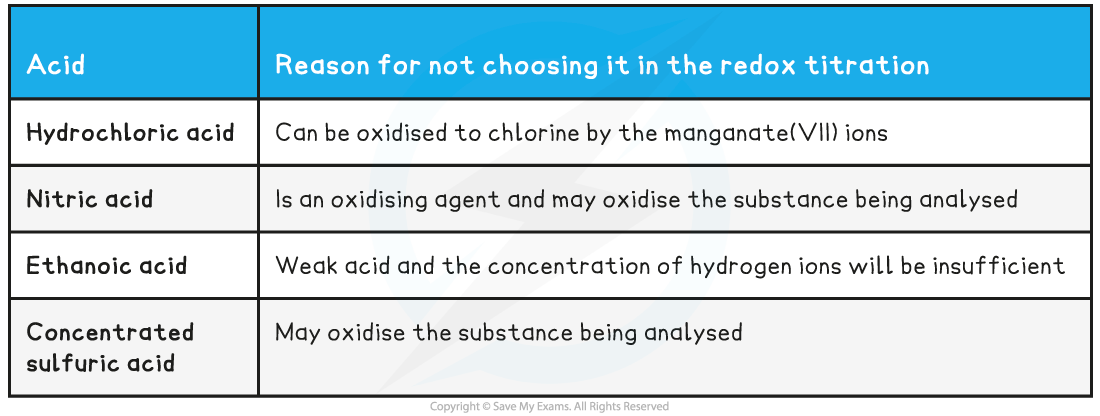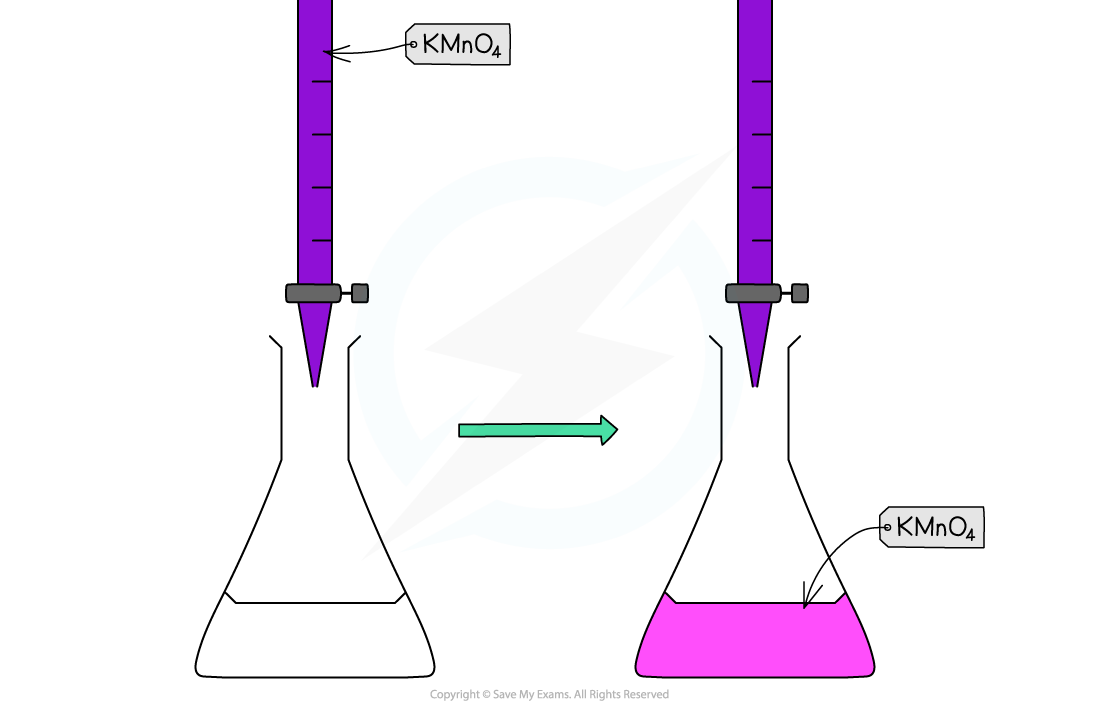Redox Titrations (AQA A Level Chemistry) : Revision Note
Redox Titrations
Redox Titrations
Iron has variable oxidation states and this characteristic can be exploited in redox titrations of Fe2+ with MnO4- or Cr2O72-
Both the manganate(VII) ion and dichromate(VI) ions can be used as strong oxidising agents to find the amount of iron(II) ions in solution
You need to be able to perform these separate redox titrations with Fe2+ and understand the colour changes in each example
Potassium manganate(VII) titrations
In these redox titrations the manganate(VII) is the oxidising agent and is reduced to Mn2+(aq)
The iron is the reducing agent and is oxidised to Fe2+(aq) and the reaction mixture must be acidified, to excess acid is added to the iron(II) ions before the reaction begins
The choice of acid is important, as it must not react with the manganate(VII) ions, so the acid normally used is dilute sulfuric acid
As it does not oxidise under these conditions and does not react with the manganate(VII) ions
You could be asked why other acids are not suitable for this redox titration in the exam so make sure you understand the suitability of dilute sulfuric acid
Table explaining why other acids are not suitable for the redox titration

Indicator and end point
Potassium permanganate acts as its own indicator, as the purple potassium permanganate solution is added to the titration flask from the burette and reacts rapidly with the Fe2+(aq)
The burette used in this practical should be one with white numbering not black, as you would struggle to read the values for your titres against the purple colour of the potassium permanganate if black numbering was used
The manganese(II) ions, Mn2+(aq), have a very pale pink colour but they are present in such a low concentration that the solution looks colourless
As soon as all of the iron(II), Fe2+(aq), ions have reacted with the added manganate(VII) ions, Mn7+(aq), a pale pink tinge appears in the flask due to an excess of manganate(VII) ions, Mn7+(aq)

Redox titration colour change for potassium permanganate and iron(II) ions
Worked Example
Equations
Find the stoichiometry for the reaction and complete the two half equations:
MnO4- (aq) + 5e- + 8H+ (aq) → Mn2+ (aq) + 4H2O (l)
Fe2+ (aq) → Fe3+ (aq) + e-
Answers:
Balance the electrons:
MnO4- (aq) + 5e- + 8H+ (aq) → Mn2+ (aq) + 4H2O (l)
5Fe2+ (aq) → 5Fe3+ (aq) + 5e-
Add the two half equations:
MnO4- (aq) + 8H+ (aq) 5Fe2+ (aq) → Mn2+ (aq) + 4H2O (l) + 5Fe3+ (aq)
Potassium dichromate(VI) titrations
Dichromate(VI) is a powerful oxidising agent when it changes from +6 oxidation state in the dichromate(VI) ion, Cr2O72-, to the +3 oxidation state in Cr3+
The two half equations are:
Cr2O72- (aq) + 14H+ (aq) + 6e- → 2Cr3+ (aq) + 7H2O (l)
6Fe2+ (aq) → 6Fe3+ (aq) + 6e-
Overall equation is:
Cr2O72- (aq) + 14H+ (aq) + 6Fe2+ → 2Cr3+ (aq) + 6Fe3+ (aq) + 7H2O (l)
Indicator and end point
The colour change for this titration is from orange to bluish green
to give a more definitive and visible endpoint, the indicator sodium diphenylaminesulfonate is used
This turns from colourless to purple at the endpoint
Examiner Tips and Tricks
General sequence for redox titration calculations
Write down the half equations for the oxidant and reductant
Deduce the overall equation
Calculate the number of moles of manganate(VII) or dichromate(VI) used
Calculate the ratio of moles of oxidant to moles of reductant from the overall redox equation
Calculate the number of moles in the sample solution of the reductant
Calculate the number of moles in the original solution of reductant
Determine either the concentration of the original solution or the percentage of reductant in a known quantity of sample
Worked Example
An iron tablet, weighing 0.960 g was dissolved in dilute sulfuric acid. A titre of 28.50 cm3 of 0.0180 mol dm-3 potassium dichromate(VI) solution was needed to reach the endpoint.
What is the percentage by mass of iron in the tablet?
Answer:
Cr2O72- (aq) + 14H+ (aq) + 6Fe2+ → 2Cr3+ (aq) + 6Fe3+ (aq) + 7H2O (l)
1 : 6 ratio of Cr2O72- : Fe2+
Number of moles of Cr2O72- =
= 5.13 x 10-4 moles
Moles of iron(II) = 6 x 5.13 x 10-4 = 3.078 x 10-3 moles
Mass of iron(II) = 55.8 x 3.078 x 10-3 = 0.1718 g
Percentage by mass =
= 17.9%

You've read 0 of your 5 free revision notes this week
Unlock more, it's free!
Did this page help you?
